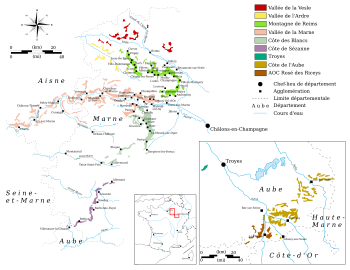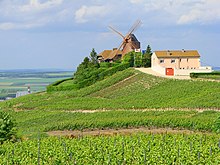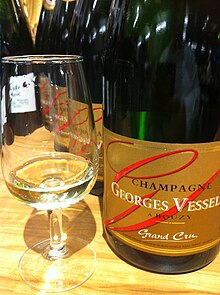Champagne wine region

The
Located at the northern edges of France, the history of the Champagne wine region has had a significant role in the development of this unique terroir. The area's proximity to Paris promoted the region's economic success in its wine trade but also put the villages and vineyards in the path of marching armies on their way to the French capital. Despite the frequency of these military conflicts, the region developed a reputation for quality wine production in the early Middle Ages and was able to continue that reputation as the region's producers began making sparkling wine with the advent of the great champagne houses in the 17th and 18th centuries. The principal grapes grown in the region include Chardonnay, Pinot noir, and Pinot Meunier. Pinot noir is the most widely planted grape in the Aube region and grows very well in Montagne de Reims. Pinot Meunier is the dominant grape in the Vallée de la Marne region. The Côte des Blancs is dedicated almost exclusively to Chardonnay.[2]
The unique, chalky landscape of the Champagne wine region and the resulting agro-industrial system led to the development of sparkling wines like champagne in the 17th century. As a result, many of the production sites and wine houses in the region were inscribed on the
Geography and climate

The Champagne province is located near the northern limits of the wine world along the
During the growing season, the mean July temperature is 18 °C (66 °F). The average annual rainfall is 630 mm (25 inches), with 45 mm (1.8 inches) falling during the harvest month of September. Throughout the year, growers must be mindful of the hazards of fungal disease and early spring frost.[5]
Ancient oceans left behind
History

The
Military conflicts
The location of Champagne played a large role in its historical prominence as it served as a "crossroads" for both military and trade routes. This also made the area open to devastation and destruction during military conflicts that were frequently waged in the area. In 451 A.D. near
During the
History of wine production

The region's reputation for wine production dates back to the
The still wines of the area were highly prized in Paris under the designation of vins de la rivière and vins de la montagne- wines of the river and wines of the mountain in reference to the wooded terrain and the river
The Champagne house of
The nineteenth century saw an explosive growth in Champagne production going from a regional production of 300,000 bottles a year in 1800 to 20 million bottles in 1850.[13]
Rivalry with Burgundy
A strong influence on Champagne wine production was the centuries-old rivalry between the region and
This development had a ripple effect throughout both regions and in the Paris markets. Both Champagne and Burgundy were deeply concerned with the "healthiness" reputation of their wines, even to the extent of paying medical students to write theses touting the
The war of words would continue for another 130 years with endless commentary from doctors, poets, playwrights and authors all arguing for their favorite region and their polemics being reproduced in advertisements for Burgundy and Champagne. On a few occasions, the two regions were on the brink of civil war.[16] A turning point occurred when several Champagne wine makers abandoned efforts to produce red wine in favor of focusing on harnessing the effervescent nature of sparkling Champagne. As the bubbles became more popular, doctors throughout France and Europe commented on the health benefits of the sparkling bubbles which were said to cure malaria. As more Champenois winemakers embarked on this new and completely different wine style, the rivalry with Burgundy mellowed and eventually waned.[16]
Classifications and vineyard regulations


In 1927, viticultural boundaries of Champagne were legally defined and split into five wine-producing districts: The Aube, Côte des Blancs, Côte de Sézanne, Montagne de Reims, and Vallée de la Marne. This area covered in 2008 33,500 hectares (76,000 acres) of vineyards around 319 villages that were home to 5,000 growers who made their own wine and 14,000 growers who only sold grapes.[4][17][18]
The different districts produce grapes of varying characteristics that are blended by the Champagne houses to create their distinct house styles. The Pinots of the Montagne de Reims that are planted on northern facing slopes are known for their high levels of acid and the delicacy they add to the blend. The grapes on the southern facing slope add more power and character. Grapes across the district contribute to the bouquet and headiness. The abundance of southern facing slopes in the Vallée de la Marne produces the ripest wines with full aroma. The Côte des Blancs grapes are known for their finesse and the freshness they add to blends with the extension of the nearby Côte de Sézanne offering similar though slightly less distinguished traits.[11]
In 1941, the
For each vintage, the CIVC rated the villages of the area based on the quality of their grapes and vineyards. The rating was then used to determine the price and the percentage of the price that growers get. The Grand Cru rated vineyards received 100 percent rating which entitled the grower to 100% of the price. Premier Crus were vineyards with 90–99% ratings while Deuxième Crus received 80–89% ratings.[2] Under
Revision of the Champagne region

The worldwide demand for Champagne has been continuously increasing throughout the 1990s and early 2000s. A record in worldwide shipping of Champagne (including domestic French consumption) of 327 million bottles was set in 1999 in anticipation of end of millennium celebrations, and a new record was set in 2007 at 338.7 million bottles.[19] Since the entire vineyard area authorized by the 1927 AOC regulations is now under cultivation, various ways of expanding the production have been considered. The allowed yield was increased (to a maximum of 15,500 kg per hectare during an experimental period from 2007 to 2011[20]) and the possibility of revising the production region was examined.
After an extensive review of vineyard conditions in and around the existing Champagne region,
The proposed 40 new Champagne villages are located in four départements:[23][24]
- 22 in Marne: .
- 15 in .
- Two in Champcourtand Harricourt.
- One, Marchais-en-Brie, in Aisne.
The INAO proposal was to be subject to review before being made into law and was immediately questioned in numerous public comments. The mayor of one of the villages to be delisted, Germaine, immediately appealed against INAO's proposal, with the possibility of additional appeals by vineyard owners.[17][25] The initial review process is expected to be finished by early 2009. This will be followed by another review of the specific parcels that will be added or deleted from the appellation. The earliest vineyard plantings are expected around 2015, with their product being marketed from around 2021. However, the price of land that are allowed to be used for Champagne production is expected to immediately rise from 5,000 to one million euro per hectare.
While some critics have feared the revision of the Champagne region is about expanding production irrespective of quality, British wine writer and Champagne expert Tom Stevenson has pointed out that the proposed additions constitute a consolidation rather than expansion. The villages under discussion are situated in gaps inside the perimeter of the existing Champagne regions rather than outside it.[21]
As of 2019, the expansion had not happened, with a final decision expected in 2023[26] or 2024.[27]
Production other than sparkling wine
While totally dominating the region's production, sparkling Champagne is not the only product that is made from the region's grapes. Non-sparkling still wines, like those made around the village
The
Traditions
The end of harvest in Champagne is marked by a celebration known as la Fête du Cochelet.[28] At Reims, "St Jean is the patron of the cellar staff and those engaged in work connected with Champagne."[29]
See also
- Champagne Riots
- Oeil de Perdrix, wine style believed to have been invented by the Champenois
References
- ^ "Champagne Paris wine tours". Paris Digest. 2019. Retrieved 2019-03-08.
- ^ ISBN 1-74048-050-3.
- ^ "Champagne Hillsides, Houses and Cellars". UNESCO World Heritage Centre. United Nations Educational, Scientific, and Cultural Organization. Retrieved 12 December 2021.
- ^ ISBN 1-74048-050-3
- ^ ISBN 1-84000-332-4
- ISBN 0-06-621282-0
- ISBN 0-671-68702-6
- ISBN 0-671-68702-6
- ISBN 0-671-68702-6
- ^ ISBN 1-74048-050-3
- ^ ISBN 1-84000-332-4
- ISBN 0-671-68702-6
- ISBN 0-06-621282-0
- ISBN 0-06-073792-1
- ISBN 0-06-073792-1
- ^ ISBN 0-06-073792-1
- ^ a b c Kevany, Sophie (March 14, 2008). "New Champagne areas defined". Decanter.com. Retrieved 2008-03-15.
- ^ Bremner, Charles (2008-03-14). "Champagne region expanded to meet world demand". The Times. London. Retrieved 2008-03-15.
- ^ Fallowfield, Giles (March 4, 2008). "Champagne shipments and exports hit new high". Decanter.com. Retrieved 2008-03-15.
- ^ Fallowfield, Giles (October 22, 2007). "Record harvest in Champagne". Decanter.com. Archived from the original on October 23, 2007. Retrieved 2008-03-15.
- ^ a b Wine-pages.com: Champagne's €6 billion expansion Archived 2008-04-27 at the Wayback Machine, by Tom Stevenson; written November 2007 and accessed on March 17, 2008
- ^ Kevany, Sophie (March 14, 2008). "Winners and losers revealed in Champagne shake-up". Decanter.com. Archived from the original on March 18, 2008. Retrieved 2008-03-15.
- ^ Fallowfield, Giles (November 10, 2007). "France aims to extend Champagne region". Decanter.com. Archived from the original on December 16, 2007. Retrieved 2008-03-15.
- ^ Kevany, Sophie (March 17, 2008). "Champagne: the 40 new communes". Decanter.com. Archived from the original on April 12, 2008. Retrieved 2008-03-17.
- ^ Kevany, Sophie (March 17, 2008). "Champagne: Germaine appeals, Orbay accepts". Decanter.com. Archived from the original on April 15, 2008. Retrieved 2008-03-17.
- ^ "Pourquoi la Champagne va subir son plus grand bouleversement depuis 1927". France 3 Grand Est (in French). Retrieved 16 June 2022.
- ^ Sage, Adam. "Champagne region expansion uncorks grapes of wrath". Retrieved 16 June 2022.
- ^ Ross, Harold Wallace; Shawn, William; Brown, Tina; Remnick, David; White, Katharine Sergeant Angell; Irvin, Rea; Angell, Roger (1963). The New Yorker.
- ISBN 9780684137568.
